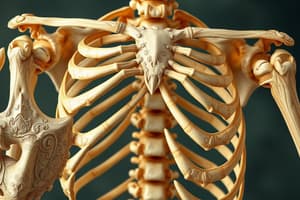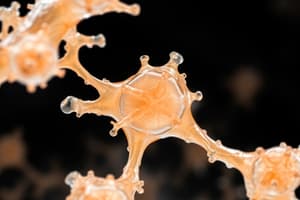Podcast
Questions and Answers
What is the primary hormone that decreases blood calcium levels?
What is the primary hormone that decreases blood calcium levels?
- Parathyroid Hormone
- Thyroxine
- Calcitonin (correct)
- Growth Hormone
Which of the following skeletal disorders is characterized by an exaggerated lumbar curve?
Which of the following skeletal disorders is characterized by an exaggerated lumbar curve?
- Osteoporosis
- Lordosis (correct)
- Kyphosis
- Scoliosis
What percentage of the body's calcium is stored in the skeleton?
What percentage of the body's calcium is stored in the skeleton?
- 25%
- 50%
- 75%
- 99% (correct)
Which bone is typically replaced every four months?
Which bone is typically replaced every four months?
What condition is described as normal loss of bone associated with aging?
What condition is described as normal loss of bone associated with aging?
What type of fracture is characterized by compression of the vertebral body height?
What type of fracture is characterized by compression of the vertebral body height?
Which hormone increases osteoclast activity when blood calcium levels decrease?
Which hormone increases osteoclast activity when blood calcium levels decrease?
Which term describes the mild to severe condition where the lamina of vertebrae fail to unite at midline?
Which term describes the mild to severe condition where the lamina of vertebrae fail to unite at midline?
What is one primary function of the skeletal system related to blood?
What is one primary function of the skeletal system related to blood?
Which type of bone is primarily involved in the strength of long bones?
Which type of bone is primarily involved in the strength of long bones?
What are osteoblasts primarily responsible for in the context of bone tissue?
What are osteoblasts primarily responsible for in the context of bone tissue?
Which statement accurately describes intramembranous ossification?
Which statement accurately describes intramembranous ossification?
In bone histology, what connects osteocytes within the bone matrix?
In bone histology, what connects osteocytes within the bone matrix?
What differentiates spongy bone from compact bone?
What differentiates spongy bone from compact bone?
Ossification refers to what process in bone biology?
Ossification refers to what process in bone biology?
What is the significance of the epiphyseal plate in long bone growth?
What is the significance of the epiphyseal plate in long bone growth?
What role do osteoclasts have in bone health?
What role do osteoclasts have in bone health?
Which of the following bone types is characterized by a variable shape and functions in protection and support?
Which of the following bone types is characterized by a variable shape and functions in protection and support?
Flashcards are hidden until you start studying
Study Notes
Functions of the Skeletal System
- Provides support and movement for the body.
- Stores minerals, lipids, and energy.
- Responsible for blood cell production (hematopoiesis).
- Protects vital organs.
- Acts as a lever for muscular actions.
Classification of Bones
- Long bones: Examples include femur and humerus.
- Short bones: Examples include carpals.
- Flat bones: Examples include parietal and sternum.
- Irregular bones: Examples include vertebrae and pelvis.
- Sesamoid bones: Develop in tendons; patella is a key example.
- Sutural bones: Variably shaped bones within the skull.
Bone Structure Types
- Compact bone: Dense and forms outer layer.
- Spongy bone: Cancellous, with internal spaces.
Typical Long Bone Anatomy
- Diaphysis: The long shaft.
- Epiphyses: The ends of the bone.
- Metaphysis: Junction between diaphysis and epiphysis.
- Articular cartilage: Hyaline cartilage covering joints.
- Marrow cavity: Hollow center filled with red or yellow marrow.
- Periosteum: Covering of the bone; contains fibrous and cellular layers.
Bone Histology
- Composed of osseous tissue with a solid matrix and collagen protein fibers.
- Cells include:
- Osteocytes: Mature bone cells within lacunae.
- Osteoblasts: Immature cells that synthesize new matrix (osteogenesis).
- Osteoclasts: Cells that dissolve the bone matrix.
- Osteoprogenitor cells: Precursor cells that develop into osteoblasts.
Compact Bone Structure
- Osteon (Haversian System): Basic unit with concentric lamellae surrounding a central canal containing blood vessels.
- Perforating canals: Connect osteons.
- Trabeculae: Irregular lattice structure found in spongy bone.
Bone Development and Growth
- Ossification: Transition from other tissues to bone.
- Calcification: Calcium salt deposition in tissues.
- Endochondral ossification: Hyaline cartilage model is replaced by bone, starting at primary ossification centers.
- Intramembranous ossification: Bone forms directly without a cartilage model; occurs in some skull bones.
Bone Remodeling
- Continuous process of replacing old bone with new tissue.
- Influenced by stress/exercise; 25% of bone is replaced annually.
- Involves hormones regulating bone remodeling, including growth hormone, thyroxine, calcitonin, and parathyroid hormone (PTH).
Fracture Repair Process
- Involves formation of a fracture hematoma, followed by external and internal calluses.
Bone Markings
- Characteristics include elevations, projections, depressions, grooves, and tunnels which provide anatomical significance.
Aging and Skeletal Disorders
- Osteopenia: Normal bone loss with aging.
- Osteoporosis: Severe bone loss impacting function; risk factors include age, sex, race, genetics, diet, and exercise.
- Kyphosis: Exaggerated thoracic curvature.
- Lordosis: Exaggerated lumbar curve.
- Scoliosis: Abnormal lateral curvature.
- Spina bifida: Failure of vertebra lamina to unite.
- Herniated disc: Nucleus pulposus bulges and compresses nerves.
- Compression fractures: Loss of vertebral height requiring treatment.
Studying That Suits You
Use AI to generate personalized quizzes and flashcards to suit your learning preferences.




